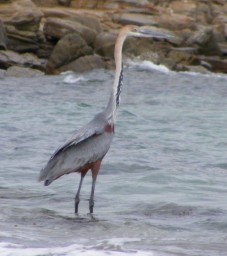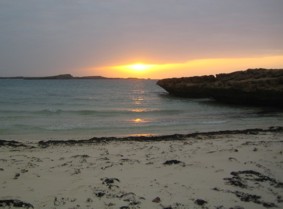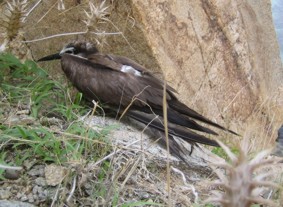|
Birdwatching in Eritrea Dahlak Islands |
||
| Home |
Introduction The Dahlak Islands and the surrounding Red Sea waters represent one of the most pristine marine environments in Africa, possibly in the world. A low population, traditional, non-intensive fishing and farming methods, and little tourism or industrial development have ensured that the Dahlaks have remained relatively unchanged over the last 100 years. The Dahlak Islands constitute yet another ecosystem in Eritrea within the Sahara Sindian biome, with many species of breeding seabirds and extensive movement of Palaearctic migrants, some of which winter on and around the islands. Because of the low human population, the birds can be quite tame, and it is often possible to get very close to feeding or breeding birds, and nesting sites. Obviously, it goes without saying that you should always avoid disturbing breeding birds, and on uninhabited islands, watch where you are walking - to avoid treading on eggs.
It is advisable to visit the Dahlak Islands during the winter months or the early spring from November to April, as temperatures are bearable then. Between July and September they can soar up to 45oC. Some birds (most tern and gull species, Crab Plover, Eurasian Spoonbill) breed during the summer, although others (lark species, Osprey, Caspian Tern) breed during the winter months when there is more rain. Cloud cover is common during the winter, reducing the heat of the sun, and the likelihood of sunburn.
Getting There To get to the Dahlak Islands, it is usually necessary to charter a private boat, which can be costly. It is best to organise the boat through one of the experienced travel agents in Asmara, such as Travel House International (Tel: 201881 – see Travel and Accommodation page for full details) or Explorer (Tel: 201392), or you could go direct to the Eritrean Diving Centre in Massawa (Tel: 552688), who have their own boats and packages, although they obviously specialise in diving trips. Currently only 20 or so islands are open to visitors, most of these in the main Dahlak Archipelago. Be aware that you need a travel permit, and permission from the Ministry of Tourism (there is an office in Massawa). Your travel agent should arrange these for you automatically, but it is always a good idea to check before you set off.
Most boats available for charter are fairly old motorboats with outboard motors, although some are newer, and one or two older yachts with sails are also available in Massawa. It takes the best part of a day to cross to Dahlak Kebir, the biggest island, from Massawa. East of Dahlak Kebir there are many small uninhabited islands important for nesting seabirds and turtles. Further south is the island of Dissei, located at the mouth of the Gulf of Zula, and several other significant islands with good mangrove forest are located just offshore of Ghela’ Elo, further south east on the way to Assab.
Accommodation on the Dahlak Islands Whichever vessel you take to get to the Dahlak Islands, it will likely be equipped to provide accommodation, either on the boat itself, or camping on beaches, using tents and mattresses provided by the vessel owner. They will also provide cooking facilities on the boat, or possibly on fires on the beach. Check with them whether they will provide the food and cooking. You will need to take all your provisions, including drinking water, with you from Massawa. There is only one hotel on Dahlak Kebir, called Luul, which is currently closed, although it may open up again in the future.
Habitat Types Coastal scrub. Acacia forest and scrub. Grazing-degraded scrub. Semi-desert scrub. Mangrove forest. Sand beaches. Reef platforms and coral cliffs up to 30m.
Research on the Eritrean Red Sea Islands The Status of Breeding Seabirds and Waterbirds on the Eritrean Red Sea Islands, published in the Bulletin of the African Bird Club, Vol. 15, No. 2; September 2008 (by Dawit Semere, Tewolde Hagos, Ghebrezghi Seleba, Yossief Gebrezgabhier, Zeweldi Haile, Giorgio Chiozzi and Giuseppe De Marchi) demonstrates the importance of the Eritrean Red Sea Islands for breeding seabirds, estimating c. 175,000 breeding pairs of 21 different recorded species, including the near-threatened White-eyed Gull and probably including the vulnerable regional endemic; the Socotra Cormorant (although this species breeds further south than the Dahlak Islands themselves). This paper has highlighted the extreme importance of these islands for many of these species, harbouring over 70% of the world breeding population of a Lesser Crested Tern subspecies (Sterna bengalensis par), over 30% of the world breeding population of White-eyed Gull, over 25% of the world breeding population of a Brown Noddy subspecies (Anous stolidus plumbeigularis), over 20% of the world breeding population of Crab Plover, 18% of the world breeding population of a Eurasian Spoonbill subspecies (Platalea leucorodia archeri), 18% of the world breeding population of a Greater Crested Tern subspecies (Sterna bergii velox), nearly 10% of the world breeding population of a Brown Booby subspecies (Sula leucogaster plotus) and 6% of the world breeding population of White-cheeked Tern, as well as others. This indicates that the Eritrean Red Sea Islands are of worldwide significance for seabirds, and are in clear need of protection.
Where to Watch Birds
Here I have included information on only a small number of islands, mainly ones that are easily accessible to visitors, ostensibly in the Dahlak Archipelago proper.
Dahlak Kebir As the largest island, Dahlak Kebir has all the above listed habitat types, so you would do well to spend plenty of time exploring around the many inlets and bays on the island, taking regular excursions inland on foot wherever it’s convenient to moor the boat. There are significant coral cliffs around some parts of the island, making it difficult to get ashore, but the bays, when you find them often have good concentrations of shorebirds, such as waders, heron species, gulls and terns. Birds: Brown Booby, Pink-backed Pelican, Green-backed Heron, Western Reef Heron, Great White Egret, Greater Flamingo, Abdim’s Stork, Osprey, Black Kite, Egyptian Vulture, Hooded Vulture, Sooty Falcon, Arabian Bustard, Crab Plover, Bar-tailed Godwit, Whimbrel, Eurasian Curlew, Common Redshank, Common Sandpiper, Sanderling, Little Stint, Lesser Black-backed Gull, Sooty Gull, White-eyed Gull, Slender-billed Gull, Lesser-crested Tern, Caspian Tern, Common Tern, Sandwich Tern, Chestnut-bellied Sandgrouse, Blue-spotted Wood Dove, Speckled Pigeon, African Collared Dove, Black-crowned Sparrow Lark, Somali Crow, Pied Crow, Blackstart, Common Fiscal, Southern Grey Shrike
Dissei (sometimes spelt Disse or Dise) Dissei is located at the mouth of the Gulf of Zula, which is the beginning of the Great Rift Valley. The island is geologically different to most of the Dahlaks, as it is not a coral island. It is quite hilly and there is not much vegetation, due to overgrazing (the island has a small human population), although small areas of acacia scrub can be found in some of the bays and valleys facing east. There is little, if any, freshwater on Dissei. Many of the beaches can be productive for waders, especially during migration periods, and the hills and small areas of forest can be excellent for migrants, some of which overwinter on the island. Further north of Dissei is the tiny uninhabited reef island of Madote, where Osprey, Caspian Tern, Greater Crested Tern, Lesser Crested Tern, White-cheeked Tern and Bridled Tern all breed. Half way between Dissei and the Buri Peninsula there is a small rocky island called Seil, stained white by bird excrement, where Sooty Falcon, Eurasian Spoonbill and Red-billed Tropicbird are all known to breed.
Birds: Brown Booby, Pink-backed Pelican, Goliath Heron, Western Reef Heron, Abdim's Stork (breeding), Osprey (breeding), Peregrine Falcon, Sooty Falcon, Common Quail, Arabian Bustard, Crab Plover, Curlew, Redshank, Common Sandpiper, Sanderling, Yellow-legged Gull, Lesser Black Backed Gull, Sooty Gull, Caspian Tern, Greater Crested Tern, Lesser Crested Tern, Common Tern, White-cheeked Tern, Bridled Tern, Pied Crow
Sheik Said or Green Island
Smaller Uninhabited Islands As mentioned above, many of the smaller islands serve as nesting sites for a good variety of gull, tern and plover species as well as 4 species of turtle. Birds: Red-billed Tropicbird, Masked Booby, Brown Booby, Socotra Cormorant, Pink-backed Pelican, Green-backed Heron, Western Reef Heron, Goliath Heron, Abdim's Stork, Sacred Ibis, Eurasian Spoonbill, Osprey, Sooty Falcon, Crab Plover, Kentish Plover, Whimbrel, Eurasian Curlew, Common Redshank, Sanderling, Little Stint, Yellow-legged Gull, Lesser Black-backed Gull, Sooty Gull, White-eyed Gull, Slender-billed Gull, Caspian Tern, Greater Crested Tern, Lesser Crested Tern, White-cheeked Tern, Common Tern, Bridled Tern, Saunder's Tern, Brown Noddy
Recommended... Dahret An island close to Dohul with areas of grassland that attract good numbers of passage migrants. Nesting species including Crested Lark, Osprey, Bridled Tern, White-cheeked Tern, Crab Plover and Kentish Plover. There is some very good diving reef as well. Dur ghella Here there is some mangrove forest. Nesting species include Brown Booby, Sooty Gull, Red-billed Tropicbird and White-eyed Gull. Dohul Bahut Not to be confused with Dohul. There are good mangrove forests here. Breeding species include Eurasian Spoonbill, Reef Heron and White-eyed Gull. Avoid camping on this island due to the feral wild rats.
Acknowledgement: Many thanks to Giuseppe De Marchi for large amounts of the information given on this page. |
|
| Eritrea Information | ||
| Abyssinian Endemics | ||
| Bird Checklist for Eritrea | ||
| Travel & Accommodation | ||
| In Italiano | ||
| Photos | ||
| Other Wildlife | ||
| Asmara Birdwatching | ||
| Filfil Birdwatching | ||
| Adi Keih Birdwatching | ||
| Massawa Birdwatching | ||
| Dahlak Islands Birdwatching | ||
| Elabered / Keren Birdwatching | ||
| Gash Barka Birdwatching | ||
| Contacts and Services | ||
| Links | ||
| Children and Schools | ||
|
|
||


